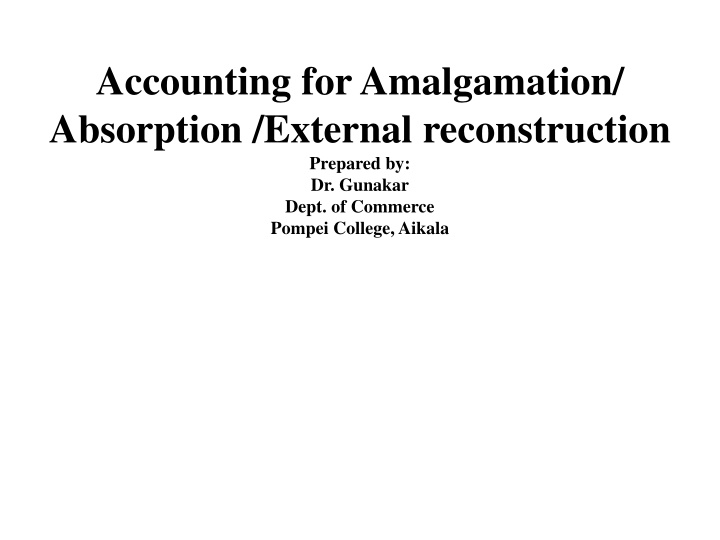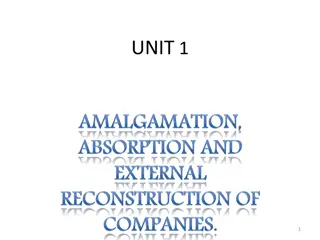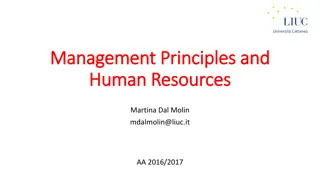
Accounting for Amalgamation, Absorption, and External Reconstruction
Dive into the world of accounting for amalgamation, absorption, and external reconstruction with comprehensive insights on concepts, types, purchase considerations, and procedures. Learn about the reasons behind merges, acquisitions, and amalgamations, along with types of amalgamations such as merger and purchase nature. Explore the detailed aspects of amalgamation in the nature of merger and purchase, covering assets, liabilities, shareholder considerations, and more in this informative guide.
Download Presentation

Please find below an Image/Link to download the presentation.
The content on the website is provided AS IS for your information and personal use only. It may not be sold, licensed, or shared on other websites without obtaining consent from the author. If you encounter any issues during the download, it is possible that the publisher has removed the file from their server.
You are allowed to download the files provided on this website for personal or commercial use, subject to the condition that they are used lawfully. All files are the property of their respective owners.
The content on the website is provided AS IS for your information and personal use only. It may not be sold, licensed, or shared on other websites without obtaining consent from the author.
E N D
Presentation Transcript
Accounting for Amalgamation/ Absorption /External reconstruction Prepared by: Dr. Gunakar Dept. of Commerce Pompei College, Aikala
Outline of the chapter Concepts Types of amalgamation Purchase consideration and its calculation Accounting procedures
Reasons Merges/Absorption/Amalgamations/acquisitions Increase in effective value Economies of scale Operating economies Elimination of competition Tax implications Backward /forward integration Better financial planning Stabilization through diversification Growth
Types of Amalgamation: Amalgamation in the nature of merger & Amalgamation in the nature of purchase
Amalgamation in the nature of merger i. All the assets and liabilities of the transferor company become (after amalgamation), the assets &liabilities of the transferee company ii. ii. Shareholders holding not less than 90% of the face value of the equity shares of the transferor company (other than equity shares immediately before amalgamation of the transferor company or its subsidiaries or their nominee) become equity shareholders of the transferee company by virtue of an amalgamation. iii. The consideration to the shareholders of the transferor company (willing to become equity shareholders of the transferor company) is discharged by the transferee company wholly by the issue of shares in the transferee company except that cash may be paid in respect any fractional shares. already held therein,
iv. The business of the transferor company is intended to be carried on after amalgamation by the transferee company. v. No adjustment is intended to be made to the book- values of the assets and liabilities of the transferor company when they are incorporated in the financial statements of the transferor company except to ensure uniformity of accounting policies. Thus there is pooling of assets and liabilities of the combining entities amalgamation. Equity combining entities continue to have a proportionate share in the combining entity. under shareholders this type of of the
Amalgamation in the nature of purchase If any one or more of the conditions satisfied for the mergers are not satisfied, the amalgamation is considered as amalgamation in the nature of purchase.
Difference between Amalgamation in the nature of merger and in the nature of purchase. In the case of amalgamation in the nature of merger, there is genuine merger or pooling of all assets and liabilities and shareholders interest of amalgamating companies. But in the case of amalgamation in the nature of purchase there is no genuine pooling of assets and liabilities and shareholders interest amalgamating company s. In case of amalgamation in the nature of merger business of the Transferor Company or companies is continued by the transferor company. But in the case of amalgamation in the nature of purchase there may or may not be continuation of the business of transferor company by the transferee company. of the
In the case of amalgamation in the nature of merger, the shareholders company have proportionate share in the equity of the transferee company. On the other hand in the case of amalgamation in the nature of purchase the shareholder s of the transferee company do not continue to have a proportionate share in the equity of the transferor company. The accounting treatment for amalgamation in the nature of merger differs from the accounting treatment for amalgamation in the nature of purchase, particularly in the books of the transferee company. of the transferor
Methods of calculating purchase consideration There are four methods for calculating the purchase consideration. Lump-Sum method Net worth or net assets method Net payment method Intrinsic worth method
Lump-sum method: Under the method transferee company agrees to pay a fixed a sum to the transferor company. It is specially given and need not be calculated. For Eg: if A limited purchases the business of Y limited and agrees to pay Rs. 25,00,000 in all, it is an example of lump sum payments. Net Assets method: under this method purchase consideration is calculated by calculating the net worth of the assets taken over by the transferee company. It is arrived at by adding the agreed value of assets taken over by the transferee company minus agreed assumed by the transferee company. value of liabilities
The following points must be considered under this method. The term assets taken over include cash in hand or cash at bank unless otherwise stated, but shall not include fictitious assets as preliminary expenses, discount on issue of shares or debentures, underwriting commission, debit balance of P & LA/c. If a particular asset is not taken over by the transferee company, it should not be included in purchase consideration. The term liabilities taken over mean all liabilities to third parties (excluding company and shareholders). The trade liabilities taken over include trade creditors & bills payable (B/P). It will exclude other liabilities to third party- bank overdraft (B.O.D). outstanding expenses (o/s exp), tax liability etc.
If a fund or portion of a fund denotes liability to third parties, the same must be included in the liability as staff provided fund, workmen s savings bank A/c, workman s profit sharing fund workman s compensation fund. The term liabilities will not include past accumulated profits or reserves such as general reserve, dividend equalization fund, reserve fund, sinking fund capital reserve, share premium a/c, capital redemption reserve a/c P & L A/c as there are payable to shareholders & not to third parties. The term business will always mean both the assets and liabilities. If any liability is not taken over by the transferee company the same should not be included in the purchase consideration. Goodwill value agreed to be paid by the transferee company is added in the purchase consideration.
Net Payment Method: Under this method purchase consideration calculated by adding the various payments in the form of shares, debentures and other securities, cash etc. made to shareholders of the company. Therefore purchase consideration should not include payments made to debenture holders and creditors (AS-14). Points to be noted Assets and liabilities taken over by the transferee company are not to be considered. The payments made by the transferee company for shareholders, whether in cash or shares must be considered. If creditors and debentures are taken over by the transferee company and subsequently discharged then such amount should not be added to the purchase consideration. When liabilities are not taken over by the transferee company, they , tare either added or deducted to the amount of purchase consideration.
Any payments made by the transferee company to some other party on behalf of the transferor company are to be ignored. If the liquidation expenses of the transferor company are to be borne by the transferee company these can be added to the purchase consideration. The fractional shares should be valued at the market price and paid in cash. If we add the liquidation expenses paid by to the purchase consideration, then while passing the entry in the books of purchasing company we should not pass entry for payment of liquidation expenses, b included in purchase consideration.






















